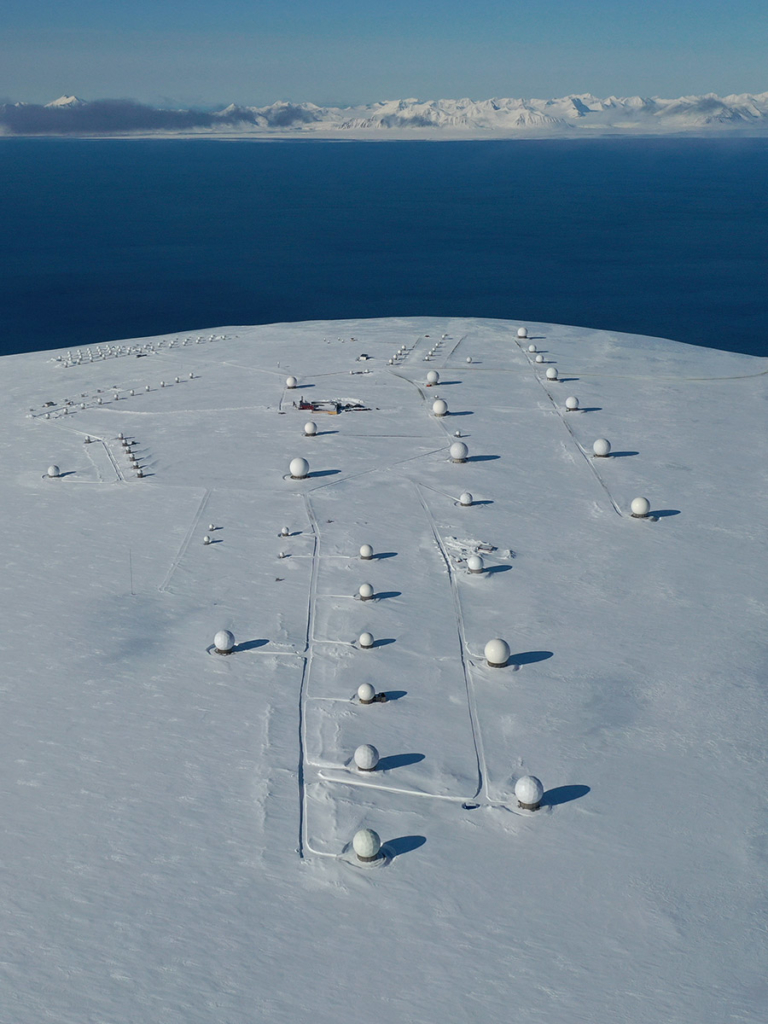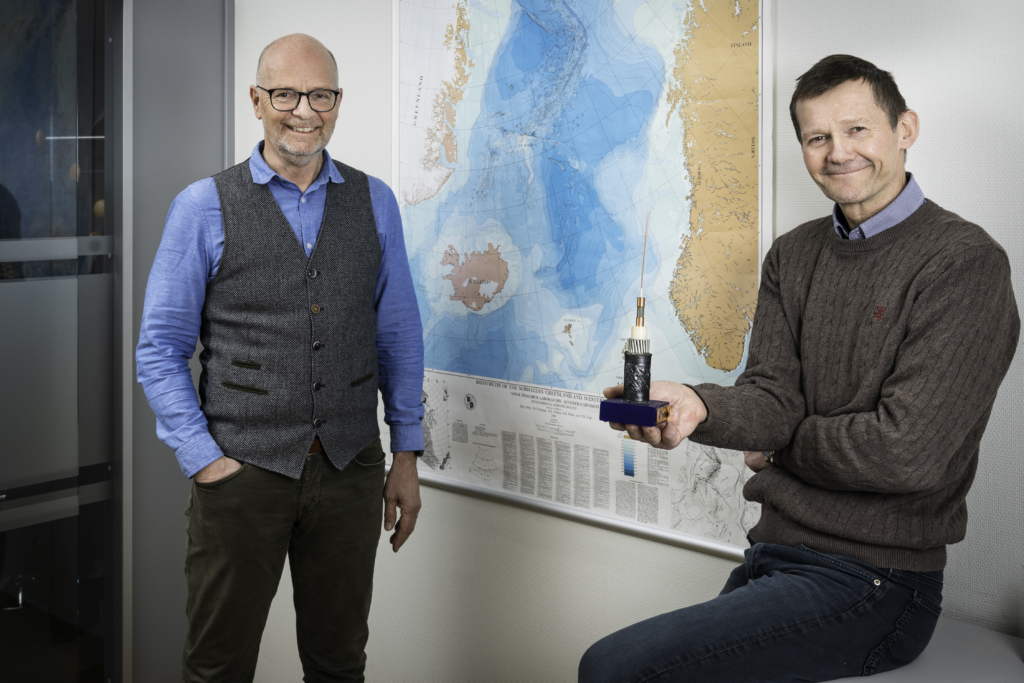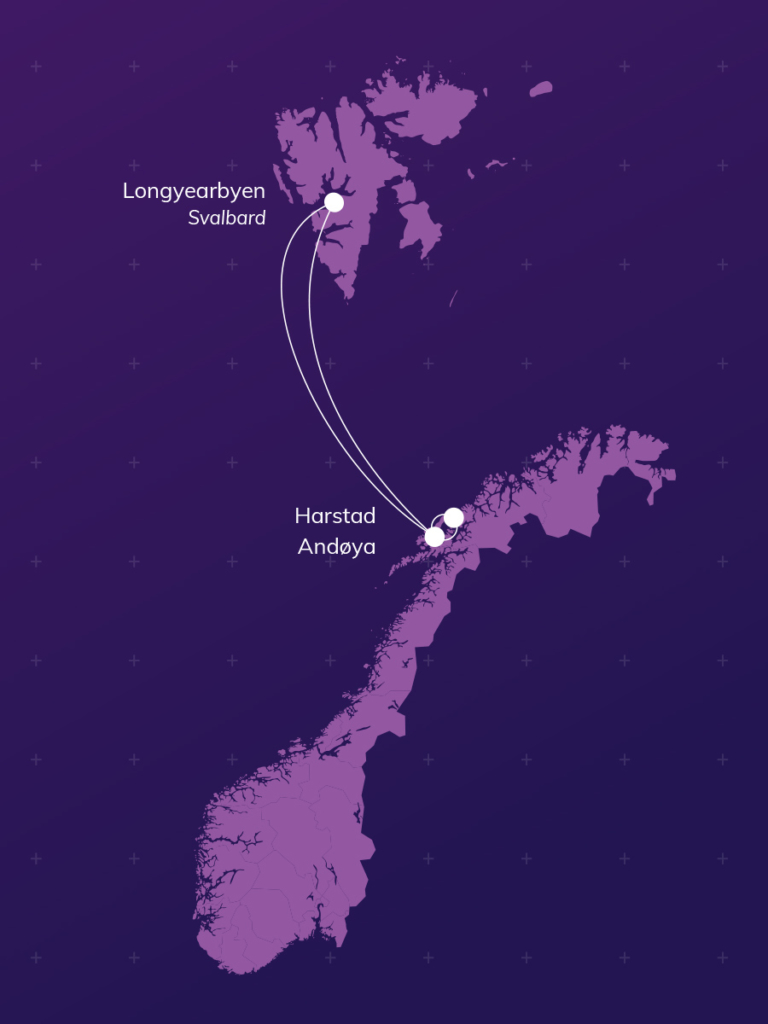Svalbard has an ideal geographical location for downloading data from satellites in polar orbits. SvalSat, the Svalbard satellite ground station at 78 degrees north, is the northernmost ground station in the world and started operation in 1997. However, development of the business depended on efficient transfer of large volumes of data to the mainland.
The station is located at Platåberget outside Longyearbyen. Satellite data were initially transmitted to customers via a geostationary satellite. However, small capacity for data transmission via satellite was a limiting factor. Around 2001, it became clear that SvalSat’s future development was entirely dependent on the efficient transfer of large volumes of data to the mainland.

At this time, SvalSat was part of Norsk Romsenter Eiendom AS (later renamed Space Norway AS), a company owned by Stiftelsen Norsk Romsenter (NRS). NRS was concerned that SvalSat would lose out on commercial opportunities because of the lack of fibre connection to mainland Norway. NRS believed that a subsea fibre connection would be essential to ensure the future development of SvalSat’s activities. The telecommunications operator at Svalbard saw no commercial basis for investing in an approximately 1,400-kilometre subsea fibre optic cable connection. In 2002, NRS initiated its own assessment and planning of a fibre connection from Longyearbyen to the mainland, with the objective of establishing such connection without any government financing.
With Space Norway as a tool, NRS succeeded in this project. Financing was secured through a combination of long-term contracts, debt, prepayments from key customers, and funding from Space Norway. Customers and partners included NASA, NOAA, KSAT, Andøya Rocket Range (today Andøya Space Center), Telenor and Uninett8. The construction was done in 2003 and the fibre connection became operational in January 2004.

The fibre connection has been of important strategic value for the growth and development of KSAT. SvalSat is now the world’s largest ground station for downloading data from satellites in polar orbits. Today, both KSAT and Space Norway are two successful spin-off businesses from NRS (Norwegian Space Agency).
The fibre connection consists of two separate cables that connect Longyearbyen to mainland Norway. The distance of approx. 1,400 km corresponds roughly to the distance between Oslo and Paris. The cables are buried approximately 2 metres in selected areas to protect against destruction by fish trawling and anchoring of ships. The sea depth reaches as much as 1,670 metres just west of Svalbard. At the time of construction, it was the world’s deepest fibre-optic cable. Tyco Communications (now SubCom) was the contractor for the project. The anticipated technical service life of the cables is 25 years. It is now 17 years since the cables became operational. The operating track record of the Svalbard connection has been excellent with few incidents that have led to interruptions of the service. During the period 2018-20, Space Norway carried out significant security related upgrades to the fibre connection.
The primary motivation for establishing the fibre-optic cable in 2004 was to ensure the growth and development of the satellite business at SvalSat. Today, the fibre connection also represents a critical resource for the society at Svalbard and enables modern electronic communication services. These are services necessary to maintain and develop society as well as Norwegian presence on the archipelago. The fibre connection is considered part of the national critical infrastructure.

National and international companies and entities depend on a functioning fibre connection to Svalbard. Information downloaded at SvalSat and distributed via the fibre connection is important for a number of purposes such as weather forecasting services, surveillance of ship traffic, environmental monitoring, development of ice maps for the Arctic and communication services in the critical phases of rocket launches9. The connection is also important for KSAT’s contribution to Galileo, Europe’s satellite-based navigation system10. Space Norway offer transmission capacity at wholesale level to a small number of customers, who in turn provide communication services in the retail and commercial markets. End customers and users of the fibre connection include a wide spectre of businesses: the society in general, the coastal radio service, Helsenett, Avinor, the Governor of Svalbard, including police and SAR (Search And Rescue) resources, local government in Longyearbyen, the Norwegian Coastal Administration with services for maritime security, EUMETSAT11, NASA, NOAA, Galileo, Iridium, ESA, the Norwegian Mapping Authority as well as university and research units on the archipelago such as UNIS, the Nansen Environmental and Remote Sensing Center and the Norwegian Institute of Marine Research etc.
Sources:
8 NASA is the National Aeronautics and Space Administration, and NOAA is the National Oceanic and Atmospheric Administration, a department under the United States Department of Trade. KSAT is Kongsberg Satellite Services.
9 LEOP, Launch and early operations phase.
10 Galileo is a satellite navigation system set up by the European Union and the European Space Agency. The system has been designed as an alternative to the military and American-controlled Global Positioning System (GPS) and the Russian GLONASS.
11 EUMETSAT is the European organisation for meteorological satellites.